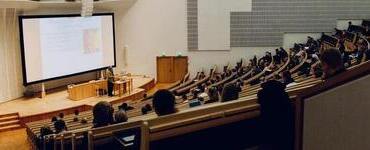Second language (L2) students often face linguistic barriers and cultural differences that make reading and writing from academic sources challenging. These students would benefit from instruction across the curriculum in using peer-reviewed sources. The aim of this article is to strengthen university-wide academic source use instruction for L2 students.
Keywords: source use, academic articles, college
Introduction
In U.S. postsecondary institutions, students read many texts. Course textbooks, nonfiction trade books, literary classics, historical documents: students’ assigned readings are varied and abundant. One particularly challenging genre in college courses is the peer-reviewed academic article. Often presented as the “gold standard” in source quality, the peer-reviewed article is valued by faculty for disseminating research carried out by experts, for being subjected to a rigorous vetting process, and for illuminating the social process of knowledge production.
The central role of the academic journal article in the intellectual life of the university leads many faculty to incorporate this genre into reading, writing, and research assignments in their courses. Beginning in first-year general education classes and continuing through advanced courses in the major, students are expected to do sophisticated work with peer-reviewed articles, including gathering, analyzing, summarizing, synthesizing, and critiquing these texts. Working with peer-reviewed sources is a challenge for any undergraduate student but may pose particular problems for second language (L2) students. Like their domestic student peers, L2 students are disadvantaged by a lack of familiarity with the genre and its broader context. Additionally, they may face linguistic barriers that interfere with reading comprehension (Neumann et al., 2019) and cultural differences that shape source integration norms (Hu & Wang, 2014). The frequent appearance of academic sources in college courses, then, may present an obstacle to L2 students’ academic success.
Given this situation, second language students would benefit from thoughtful academic source use support, spread across all four years of college. Such support, however, may not be the norm. Some faculty may not see a role for themselves in source use instruction and thus do not embed this focus into their courses. Other faculty may want to incorporate this instruction into their courses or are doing so now but struggle to know what teaching strategies would be effective. In both cases, L2 students are left underprepared to work with peer-reviewed materials.
In this piece, I draw from my professional experience as an instructor in an intensive English language program, director of a first-year writing program, and coordinator of my university’s writing across the curriculum requirement to examine L2 students’ source use instructional needs. I begin by providing context, reviewing literature on academic source use in the undergraduate curriculum and the challenges that L2 students face with source representation. I then present four instructional practices that can boost L2 students’ development with source use in any course. Given the growth in the L2 student population on U.S. college campuses due to internationalization efforts, it behooves faculty in every discipline to become skilled at coaching L2 students in academic source work. This article helps faculty succeed at this task so that their students can develop greater confidence and skill in their source work.
The need for source use instruction in the disciplines
L2 students encounter academic articles early in their programs, often as part of a required first-year writing course. Hood’s (2010) survey of writing program administrators, for example, indicated that first-year writing courses required some kind of research paper at 85% of public schools and 50% of private schools. Subsequent courses build on this foundation. In his study of roughly 800 writing assignments from forty-eight institutions, Melzer (2003) identified the “term paper” as the third most common assignment given across the curriculum. Melzer’s examples of this assignment type uniformly require students to gather and synthesize relevant disciplinary literature. Students are likely to encounter term papers in 200- to 400-level courses, including courses with a “writing” designation (e.g. “writing-intensive,” “writing-enriched”), capstone courses in the major, and any course with a strong secondary research and/or presentation component.
While encounters with academic literature are a given, consistent and effective instruction in source use is not. Library Science research has illuminated problems with source use instruction, particularly in studies on information literacy, a term used to describe “the ability to find, access, evaluate and use information” (Saunders, 2012, p. 226). In her research on faculty attitudes and practices toward information literacy, Saunders (2012) found that while faculty highly value information literacy, they lack “systematic ways to integrate it into their curriculum” and tend, instead, to take an “intermittent or ad-hoc approach to information literacy [instruction]” (p. 231). As a result of this patchwork approach, students are likely to experience gaps in support for source use, as Davis (2013) found in her case study of three Chinese graduate students.
Research on L2 students’ use of sources reinforces the need for intentional, ongoing instruction and support in working with academic sources. Source use has been characterized as “one of the most challenging of all academic literacy activities for L2 writers” (Hirvela & Du, 2013, p. 87). The difficulties observed in L2 students’ writing are many; among their findings, scholars have indicated that L2 student writing may display exact copy from original texts or too-close paraphrases, insufficient synthesis of multiple sources, a limited range of rhetorical functions for cited texts, a non-committal reporting stance toward sources, reliance on the same reporting verbs, over-citing, weak attribution of Internet sources, insufficient extraction of important information from the text, and confusion between primary and secondary sources (Davis, 2013; Lee et al., 2018; Merkel, 2020; Wette, 2010, 2018; for a comprehensive review, see Liu et al., 2016).
In light of these challenges, L2 writing scholars have argued for pedagogical interventions to help L2 students develop their source use skills within their content courses. Davis (2013) argues for greater support beyond students’ early writing courses, so that students can “continuously develop their source use” throughout college (p. 134). Likewise, Wette (2017, p. 56), recommends “ongoing attention to writing using sources strategies throughout students’ undergraduate years,” offering a range of teaching strategies to this end. What can be done beyond introductory writing courses to support L2 students’ work with academic articles? Faculty interested in delving into the literature may benefit from consulting research on L2 students’ source use challenges in the discipline (Wette, 2017, 2018). Alternatively, they may want to consult English for Academic Purposes (EAP) oriented pedagogy scholarship, such as Liu et al.’s (2016) nine-step plan for EAP instructors rooted in the core concepts of transparency, knowledge, and engagement. As a preface to more in-depth study, I offer here four principles for enriching source use support across the curriculum. These principles are derived from years of teaching first-year writing, coaching first-year writing instructors, and teaching faculty from across the curriculum. Working from this foundation, university faculty will be better equipped to help L2 students grapple with challenging texts throughout their years of study.
Principle #1: Adopt the role of “reading coach”
Effective work with academic sources presupposes strong and versatile reading skills. Such skills need deliberate, ongoing nurturing. As faculty, our immersion in the academic norms, genres, and jargon of our disciplines can lead us to underestimate the chasm that lies between the reading background of our students and our own ambitious reading expectations for them—and the important role we play in bridging this gap.
To support our students’ facility with academic texts, we can begin by broadening our identity repertoire to include the role of “reading coach.” Coaching reading is second nature to most English for Academic Purposes instructors, who often teach courses explicitly tied to reading. But for those of us who teach courses that foreground writing or discipline-specific content, assuming responsibility for L2 students’ reading development may require a shift in our instructional planning and practices. Adopting the role of “reading coach” in any course that includes academic scholarship requires us to carefully consider when, what, and how to assign and support reading in our courses.
Asking when involves evaluating reading’s breadth in our courses. Teachers can evaluate the extent to which reading is interwoven throughout their courses and ascertain whether there are overlooked opportunities to use reading to support their learning goals. For example, in my curricular work for Intensive English Program courses and multilingual first-year writing, I have increasingly sought to embed reading into every unit and to foreground the reading-writing connection from the very beginning. Often, I use short readings on the first day of class as an entry point into course content or an introduction to classroom practices, and I build on that foundation in the weeks to come. In similar fashion, faculty across the disciplines can integrate readings early and often to teach key concepts, illustrate disciplinary practices, and/or highlight real-world applications. Frequent reading opportunities support L2 students’ ongoing academic development.
Asking what involves pondering the sequence of and relationships between the texts we assign. We can infuse our instructional planning with a conditioning mindset, thinking carefully about how to build reading stamina and sophistication over the course of many weeks. L2 students’ ability to navigate challenging academic texts grows when assigned readings have been rigorously evaluated, not merely for their contributions to the subject matter but also for their contributions to students’ incremental development as readers.
Asking how involves examining the methods of instruction we adopt to nurture L2 students’ reading skills. Students need guidance in identifying claims, evidence, and reasoning across diverse texts and contexts. They need support to unpack the genre norms and audience expectations of the texts assigned. One Human Performance faculty member modeled this kind of care through teaching specific sections of academic articles. This step-by-step instruction culminated in a full critique of an academic article that asked students to find problems with the study and discuss research solutions. Reading coaches’ approaches are unique and varied; nevertheless, across instructional styles, coaches share a commitment to devoting time to purposeful, guided textual exploration.
Principle #2: Place the process under a microscope
“For your final paper, you will pick any topic from the course that interests you, gather ten library sources, and take a stance on the topic, using your research as support.” Writing prompts like this can be found in disciplines across the university. I have seen them in the cross-disciplinary faculty workshops I lead, and variations of this prompt are common in first-year writing. Bean (2011), in the popular writing across the curriculum text Engaging Ideas, calls this assignment design “the traditional method” and warns of its potentially “debilitating” effects. In response to such prompts, Bean argues, students are prone to write “wandering ‘all about’ papers,” “quasi-plagiarized data dumps,” or “resort to outright plagiarism” (p. 91).
Bean attributes students’ weak performance to instructors’ loose guidelines: the assignment instructions fail to help students envision who they are writing to, in what genre, and for what purpose. Equally problematic may be the lack of scrutiny paid to the research, reading, and writing process. Well-intentioned teachers may adopt a generic prompt while envisioning the product they hope to receive while failing to adequately explore the process it takes to get there.
Submitting our assignments under the microscope can help us identify and rectify gaps in instruction. Under such magnification, weaknesses in reading assistance are likely to come into view. Such was the case in our first-year writing program, as I examined the research support provided for L2 and domestic students. Through observing teaching assistants’ classroom instruction, I realized that a missing link existed between the source access skills taught by librarians and the source representation skills taught by first-year writing teachers. Neither party assumed responsibility for teaching source sifting, strategic reading, and content evaluating skills.
To remedy the problem, I worked with teachers to discern the sub-skills needed to succeed on a source-based assignment, an inventory worth any teacher’s time. We could then use this analysis to refine our instruction. For example, among the important skills identified was the ability to gauge a text’s relevance: students needed assistance to move from general source gathering based on keywords to a more refined and selective appraisal of sources. This realization led to in-class activities that incorporated this focus.
A similar inventory led to new instructional recommendations for a Communication Studies’ research assignment as well. Noting that the instructor’s assignment asked students to “come up with three or four claims . . . [and] back them up with supporting evidence (findings from studies),” I relayed that this would be difficult work for students at any level. I then recommended that the instructor model the process of extracting a key point from an article, rephrasing the idea, and embedding it within a larger point within a paragraph. Making these moves visible and in slow motion is the kind of microscopic work that boosts L2 students’ work with academic sources.
In general, we improve our instruction when we apply a critical lens to the research process, breaking down steps that naturally cohere for experienced researchers but that demand isolated attention for students. These efforts can lead us to be more satisfied with the quality of instruction we provide.
Principle #3: Selectively prioritize
In any writing assignment, multiple skills compete for the writer’s attention. Source use skills are learned alongside rhetorical demands, organization expectations, and sentence-level correctness. In this way, the writing student resembles the piano student—learning to coordinate notes, tempo, dynamics, and articulation all at once to achieve a successful performance.
Integrated mastery of multiple writing sub-skills is desirable, and L2 students need to be stretched by assignments that place multiple demands on them. However, taking a scaffolded approach to instruction may yield better results. Scaffolded instruction might involve mapping skills to particular assignments, weighing the relative difficulty of each skill, and moderating the other assignment demands in turn.
The evolution of one research-based assignment for international students illustrates this point well. Initially, the assignment asked students to argue for a position that they felt strongly about. They were to write for an audience and medium of their own choosing, and they needed to integrate 3-5 sources into their piece.
The simplicity of the instructions belied the difficulty of the task. Picking a topic of appropriate scope, envisioning the beliefs and values of an audience, understanding the genre requirements of their chosen medium, and gathering, reading, and using sources well were all expected. The assignment lacked a singular learning emphasis—a skill or tight set of skills at the heart of the assignment. Instead, a range of skills were given equal importance. With insufficient support provided for this broad spectrum of skills, student performance deteriorated.
A revision of this assignment compensated for the assignment’s initial failings. First, the audience for the assignment was preselected: students would address new international students enrolled in the university. This assignment design decision enabled students to write for an audience that they understood well, having recently been a part of this group. In addition to easing audience demands, genre challenges were mitigated. In lieu of being given absolute freedom (and absolute responsibility) for their genre selection, students were asked to compose in a specific, familiar, less formal genre. This assignment adaptation further lightened rhetorical demands and preserved students’ attention for other assignment requirements.
A third way in which some aspects of assignment difficulty were controlled was by providing some sources to students. Students were given topically-aligned articles that were the basis of instruction and discussion in the class. Students then had the option of using these articles in their assignments while supplementing them with additional sources. In this way, students had to worry less about finding sources and could focus more on reading, retrieving key ideas, and representing them effectively. Guided instruction on provided texts further supported this process.
Faculty in the disciplines can learn from this assignment redesign. The takeaway for faculty across-the-disciplines is to selectively prioritize some writing skills while alleviating pressure on others. This approach, paired with deliberate instruction and individualized feedback, produces better outcomes than the “work on everything, all at once” instructional pitfall.
Principle #4: Help students find value in academic literature
Ultimately, our source use aspirations for L2 students might involve more than impeccable citation and even discipline-appropriate ways of reading and writing. One laudable source use goal to which we all might aspire is to help students find value in academic scholarship, to pave the way for students to have potent experiences with academic literature as they use it for personal and/or professional enrichment. As an academic, I am able to delve into the academic literature to support my professional activities and even to answer personal questions. In times of challenge—after a miscarriage, while watching a child struggle with a physical limitation—I have leaned on academic scholarship to offer personal clarity and direction. College students are more removed from and less savvy with this well-spring of knowledge, and their opportunities to access academic literature throughout their lifetimes may be more limited. Thus, as faculty, we would do well to see academic literature as a fleeting treasure trove that L2 students cannot open themselves. We provide the keys that allow students to unlock its meaning and potential for them.
We can do so, in part, through deliberate assignment design and support. In their cross-institutional study of 700 seniors’ experiences with writing across the curriculum, Eodice, Geller, and Lerner (2017) investigated the factors that led students to identify an assignment as “meaningful.” Summarizing their findings, the researchers claim that “meaningful writing occurs when students are invited to:
- tap into the power of personal connection;
- immerse themselves in what they are thinking, writing, and researching;
- experience what they are writing as applicable and relevant to the real world; and
- imagine their future selves” (Eodice et al., 2017, p. 25).
Our assignments will yield greater yields in growth and learning if we select texts, develop in-class activities, and design assignment parameters with an eye towards helping students find meaning in academic research. On most days, we are thrilled when students can competently read and accurately represent sources in their writing; on our better days, we aim for higher: for students to be moved, empowered, enlightened, and changed by their interaction with academic texts. To fashion our instruction towards this goal should be an ongoing aim.
Conclusion
For most faculty, assuming responsibility for L2 students’ academic source use development may not initially entice. Competing priorities abound. But the need is great and the rewards plentiful. Adapting the principles I have shared will require curricular ingenuity and strategic thinking—intellectually satisfying acts of mind for any academic. Furthermore, reconceptualizing our instructional role as coach and mentor can be both ennobling and liberating. As we deepen our understanding of the aims of academic source use instruction and envision the important roles we can play, we set the stage for increased instructional effectiveness, greater professional satisfaction, and gains in student learning.
References
Bean, J. (2011). Engaging ideas: The professor’s guide to integrating writing, critical thinking, and active learning in the classroom (2nd ed). Jossey-Bass.
Davis, M. (2013). The development of source use by international postgraduate students. Journal of English for Academic Purposes, 12(2), 125-135. https://doi.org/10.1016/j.jeap.2012.11.008
Eodice M., Geller, A., & Lerner, N. (2017). What meaningful writing means for students. Peer Review, 19(1), 25-29.
Hirvela, A., & Du, Q. (2013). “Why am I paraphrasing?”: Undergraduate ESL writers’ engagement with source-based academic writing and reading. Journal of English for Academic Purposes, 12(2), 87-98. https://doi.org/10.1016/j.jeap.2012.11.005
Hood, C. L. (2010). Ways of research: The status of the traditional research paper assignment in first-year writing/composition courses. Composition Forum, 22. https://compositionforum.com/issue/22/ways-of-research.php
Hu, G., & Wang, G. (2014). Disciplinary and ethnolinguistic influences on citation in research articles. Journal of English for Academic Purposes, 14, 14-28. https://doi.org/10.1016/j.jeap.2013.11.001
Lee, J. J., Hitchcock, C., & Casal, J. E. (2018). Citation practices of L2 university students in first-year writing: Form, function, and stance. Journal of English for Academic Purposes, 33(1), 1-11. https://doi.org/10.1016/j.jeap.2018.01.001
Liu, G., Lin, V., Kou, X., & Wang, H. (2016) Best practices in L2 English source use pedagogy: A thematic review and synthesis of empirical studies. Educational Research Review, 19, 36-57.
Melzer, D. (2003). Assignments across the curriculum: A survey of college writing. Language and Learning Across the Disciplines, 6(1), 86-110.
Merkel, W. (2020). A case study of undergraduate L2 writers’ concerns with source‐based writing and plagiarism. TESOL Journal, 11(3), e00503. https://doi.org/10.1002/tesj.503
Neumann, H., Leu, S., & McDonough, K. (2019). L2 writers’ use of outside sources and the related challenges. Journal of English for Academic Purposes, 38, 106-120. https://doi.org/10.1016/j.jeap.2019.02.002
Saunders, L. (2012). Faculty perspectives on information literacy as a student learning outcome. The Journal of Academic Librarianship, 38(4), 226-236.
Wette, R. (2010). Evaluating student learning in a university-level EAP unit on writing using sources. Journal of Second Language Writing, 19(3), 158-177. http://dx.doi.org/10.1016/j.jslw.2010.06.002
Wette, R. (2017). Source text use by undergraduate post-novice L2 writers in disciplinary assignments: Progress and ongoing challenges. Journal of Second Language Writing, 37, 46-58. https://doi.org/10.1016/j.jslw.2017.05.015
Wette, R. (2018). Source-based writing in a health sciences essay: Year 1 students’ perceptions, abilities, and strategies. Journal of English for Academic Purposes, 36, 61-75. https://doi.org/10.1016/j.jeap.2018.09.006











